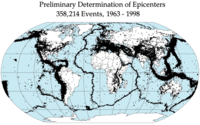
Photo from wikipedia
Tectonic faults fail in a spectrum of modes, ranging from earthquakes to slow slip events. The physics of fast earthquakes are well described by stick–slip friction and elastodynamic rupture; however,… Click to show full abstract
Tectonic faults fail in a spectrum of modes, ranging from earthquakes to slow slip events. The physics of fast earthquakes are well described by stick–slip friction and elastodynamic rupture; however, slow earthquakes are poorly understood. Key questions remain about how ruptures propagate quasi-dynamically, whether they obey different scaling laws from ordinary earthquakes and whether a single fault can host multiple slip modes. We report on laboratory earthquakes and show that both slow and fast slip modes are preceded by a cascade of micro-failure events that radiate elastic energy in a manner that foretells catastrophic failure. Using machine learning, we find that acoustic emissions generated during shear of quartz fault gouge under normal stress of 1–10 MPa predict the timing and duration of laboratory earthquakes. Laboratory slow earthquakes reach peak slip velocities of the order of 1 × 10−4 m s−1 and do not radiate high-frequency elastic energy, consistent with tectonic slow slip. Acoustic signals generated in the early stages of impending fast laboratory earthquakes are systematically larger than those for slow slip events. Here, we show that a broad range of stick–slip and creep–slip modes of failure can be predicted and share common mechanisms, which suggests that catastrophic earthquake failure may be preceded by an organized, potentially forecastable, set of processes.Both fast and slow earthquakes are preceded by micro-failure events that radiate energy. According to machine learning, these events can foretell catastrophic failure in laboratory experiment earthquakes.
Journal Title: Nature Geoscience
Year Published: 2018
Link to full text (if available)
Share on Social Media: Sign Up to like & get
recommendations!